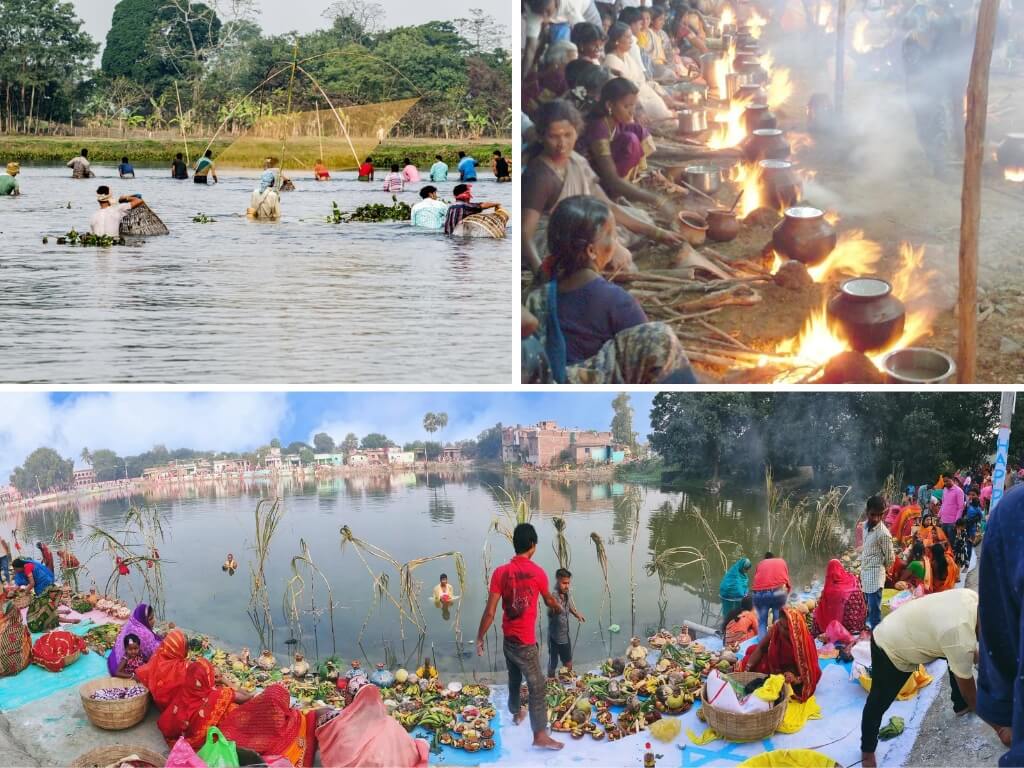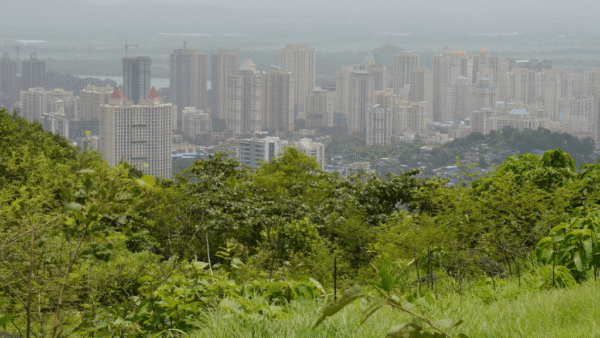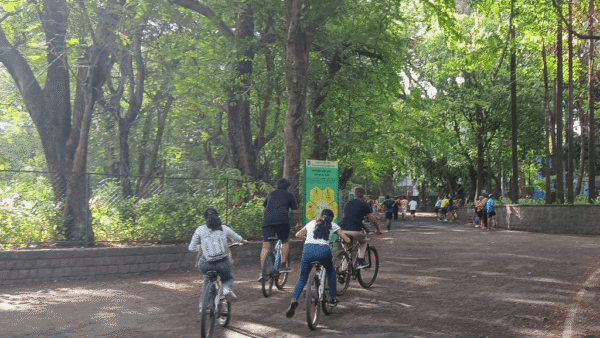A few festivals are pan-Indian though celebrated with slightly varying rituals. Others are characteristic of their region and culture. When people migrate to cities, or grow up in migrant households in cities, regional and community identities are forged through festivals and celebrations, among other aspects of socialisation. But festivals do not remain the same when people travel to cities with them – there are subtle but inescapable changes, modifications or even amalgamations that get woven into them as they acquire an urban flavour. A new twist, as it were. Cities or urban spaces are stages, hubs and platforms: “These spaces serve as more than just physical locations; they are dynamic platforms where cultural identity is expressed and celebrated, community bonds are strengthened, and economic opportunitie flourish.”[1]
Back in villages and hometowns, each season and every agrarian event used to be a celebration, and festivals were woven around the myths associated with either or both of these. When people migrate to cities, the living changes but their reference points do not, which often translates as celebration of the same festivals but with an urban flavour. The purpose, though, is not vastly different; people uphold traditions, follow rituals, strengthen family or community bonds, and showcase their culture and history. A few perceptible changes in celebrations are that they are truncated, there’s often a mix of languages, and amalgamation of traditions borrowed from other communities.
The public spaces in cities are important as they transform into venues to celebrate festivals, writes Kanchan Naik. “Our festivals are a way for us to transform the public spaces into environments that enable interactions and exchanges that are necessary for our communities and the society at large. Claiming these public spaces has greater impacts on our social fabric — beyond facilitating interactions that tie our communities together, these transformed environments also create an example of accessibility that many built spaces often fail to achieve.”[2]
Fort making

Photo: Dinesh Phate
Children in western Maharashtra and northern Karnataka make replicas of forts during Diwali, though it’s a little-known tradition these days. Around for hundreds of years, the tradition of making miniature mud forts (killas) pays homage to Chhatrapati Shivaji Maharaj, the Maratha emperor who built numerous forts in the Sahyadri mountains. It was also, perhaps, a way to initiate children into an adult theme. Families continue it even today. Children and adults ‘build’ forts complete with citadels, bastions, ramparts and moats with tanks and soldiers guarding the precincts, placing miniatures of soldiers, animals, and weapons.
Mangesh Pawar, 45, a resident of Shivaji Nagar in Kalyan, has been making killas since his childhood, a tradition from his elders. “I want my children who are in their late teens and early 20s, to know about Shivaji Maharaj’s bravery, especially since the area that we live in is also named after him,” says Pawar. Growing up, Pawar and his friends made replicas of forts in front of their houses, in the open. They now use the maidan nearby. This Diwali, Pawar, with help from his family, ‘built’ a four-feet-long fort on the ground nearby in eight days. “We needed two bullock carts of mud that cost us Rs 1,300. Unlike my childhood, we don’t have freely available mud and soil anymore because of the dense urbanisation.”
Bathukamma

During Navratri, women of Telangana and parts of Andhra Pradesh celebrate Bathukamma to worship goddess Gowramma, the giver of life. They make a conical structure with indigenous flowers, mostly which have medicinal properties, to symbolise the goddess. Anuradha Reddy, convener of INTACH Hyderabad, fondly recounts celebrating it at her maternal grandparents’ home at Bholakpur, one of Hyderabad’s traditional villages. “Women and girls came together to not just sing songs about their daily lives while dancing around the goddess but also to share their joys and sorrows with the women they grew up with,” she says, explaining that the festival comforted the women who were unable to visit their parents’ home after marriage.
Reddy talks of how this festival also has women singing songs on various episodes of a woman’s life, including how their brother visits their in-laws’ home with a saree and jewellery to take her home. After 10 days of celebrating Bathukamma, the women would walk to the nearest water body together and immerse the “goddess”. The festival is an oral tradition from the Kakatiya period and faced no disruption even during the Islamic reign in these regions, she adds.
The indigenous flowers and leaves used to make the Bathukamma have been replaced by flowers made of paper and plastic in cities; even when natural ones are used, the traditional ones are rarely available in cities. “This pollutes the water bodies and spreads diseases, which is not what the festival is about,” adds Reddy.
Bonalu

Photo: Creative Commons
Bonalu is celebrated annually in the twin cities of Hyderabad and Secunderabad, and the rest of Telangana state, during the Hindu month of Ashadam (June-July). The legend is that the festival was celebrated after soldiers from the Nizam’s regiment went to Ujjain and one of them vowed to build a shrine for Goddess Kali if his city was spared of the raging cholera epidemic in the 19th century; his wish came true which led to the building of the famous Ujjaini Mahakali temple in Secunderabad, where the cantonment used to be.
A folk festival, Bonalu has a jatara festival-cum-pilgrimage style of celebration by the Dalit and Bahujan communities, in which a village annually reveres the village deities appealing to them for protection from disease and calamity. The tradition of worshipping village deities has been carried to the highly urbanised Hyderabad though the appeal would now be termed as superstition.[3]
The festival is also believed to be a celebration of the homecoming of Goddess Mahakali during which she is served a feast – bonam is derived from bhojanam which means meal or feast – of rice cooked in milk and jaggery, carried in a pot with neem leaves, turmeric, and an earthen lamp by women. This includes rangam or a ritual in which a particular woman foretells the future. Reddy says that the woman who did the rangam in 2020 predicted a disease while the 2023 rangam predicted fires which the city is seeing frequently this year. Reddy also points to the women-centric celebration of Bonalu: “Women carry the pots and are escorted by Potharaju who is supposed to be the brother and protector of goddess Mahakali.”
Bonalu received ‘state festival’ status in the newly-formed Telangana state in 2014, and for years has been used as a symbol of the unique traditions of Telangana during the struggle for a separate state.
Narali Purnima

Photo: Wikimedia Commons
The fishing community in Maharashtra, Goa and Karnataka celebrate Narali Poornima to mark the beginning of the fishing season after the monsoon break. ‘Naral’ is Marathi for coconut and ‘purnima’ means full moon. The festival is celebrated on the full moon day at the end of the monsoon. Fisherfolk decorate their boats, offer coconuts and flowers to Varuna (god of the ocean), express their gratitude for providing them their livelihood, while also asking for protection from the dangers of the ocean.
Kadambari Koli Tandel, co-founder of Tandel Fund of Archives which is documenting the lives and stories of the community in Mumbai, says, “Women used to offer their green bangles, which are a sign of being married, with their left hand to the sea along with the coconut. It was to tell the gods to protect their husbands during the fishing season. Many have stopped this custom as Koli men have taken up other professions due to low fish availability of fish in the sea, encroachments and industrialisation.” The community still celebrates with the same gusto, dance and song, but the women do not pray for the protection of their men at sea, she adds.
Poush Mela

Photo: Wikimedia Commons
Marking the beginning of harvest season in December, Poush Mela in Santiniketan, West Bengal, usually spans six days. The annual festival that started in 1894, Poush Mela provides a platform to a myriad of activities like Bengali folk dance, Baul music performances and jatra palas (open air theatre), along with amusement rides and garners a lot of visitors through stalls for local Dhokra art, handicrafts, fabrics, household items, toys, snacks and more. According to the Bengali calendar, the month starts on December 17 this year; Poush Mela will commence on the seventh day.
Poush Mela was originally established to bring together rural and urban folk in Santiniketan, but has managed to transform into an almost month-long celebration supporting various local cultures and communities. “In Kolkata, we consider Durga Puja to be the beginning of the festive season. In West Bengal, there are numerous festivals and most of these are community-specific festivals, and also inter-community festivals. There are indigenous festivals such as Poush Mela held during December, when it turns cold in Kolkata. That’s when the new crop arrives and food is prepared with that,” reminisces Dr Rajarshi Mitra, assistant professor at the Indian Institute of Information Technology (IIIT), Guwahati.
In 1894, the first Poush Mela was organised coinciding with the inauguration of Santiniketan’s Brahman Mandir (constructed in 1891), on the seventh day of Poush in the field opposite the mandir. This is when Maharshi Devendranath Tagore, father of Rabindranath Tagore, with 12 others, adopted the ‘Brahmo’ creed to become members of “an eclectic Hindu theistic society noted for its pronounced monotheism and vigorous policy of social and political reform”.[4] Maharshi wanted to “set up a platform of interaction between rural community and the rather well-educated followers of Brahmoism as well as assemblage of all religions.”[5]
With Poush Mela and Santiniketan sharing common ground, Dr Mitra also notes the role of institutions in its organisation. “Tagore reinvigorated the Mela in Santiniketan. This fair was a community-driven economy. The Visva-Bharati belief was that the university system should not blindly follow the West but have its own celebrations and education. Initially, Visva-Bharati patronised Poush, decided on vendors. Today, anyone can put up a stall during Poush Mela,” says Dr Mitra.
It has turned into a commercial event with events across West Bengal. Though it was cancelled a few times, it is renewed with fervour. Food is not far; traditional dishes made from the season’s harvest.[6] “Fresh rice from the new paddy crop is used to make pitha, paatishapta, payesh and more. Sap from date palm trees is extracted to make date palm jaggery to be used in sweets — this is very expensive in the market if it’s fresh.”
Raja festival

Photo: Ommcom News
The three-day Raja festival, celebrated by young unmarried girls in Odisha, is a commemoration of menstruation and womanhood. Celebrated in June, it also marks the onset of monsoon. The belief that Mother Earth menstruates keeps farmers from ploughing, weeding and sowing thus allowing the land to renew itself. Young women and girls take a break from work on the three days, wear new clothes, decorate their feet with alta (red liquid) and play-sing on decorated swings.
Elisa Patnaik, communication specialist, remembers celebrating Raja in her grandmother’s house in Bhubaneswar and gorging on traditional delicacies such as Podo Pitha baked in an earthen chullah. “I used to have new dresses for all the three days. The mandatory Rajo Doli or the makeshift swing was fixed a day earlier. There was an all-pervading gaiety and festivity in the house with all cousins around,” she recalls, adding that, with urbanisation, it has ceased to be an elaborate family festival as joint families broke apart and people adopted hectic schedules.
“Raja is now popular in urban areas albeit with marketing strategy, shopping malls and hotels announcing curated festival menu, and free gifts. However, very few know why it is celebrated; moreover, it is not feasible to do some of the customs in our homes now,” says Patnaik. Houses no longer have open courtyards or trees for the swing. “My mother-in-law still manages to put up the swing and I love continuing the tradition for my 12-year-old daughter,” adds Patnaik.
Cover photos: Wikimedia Commons




